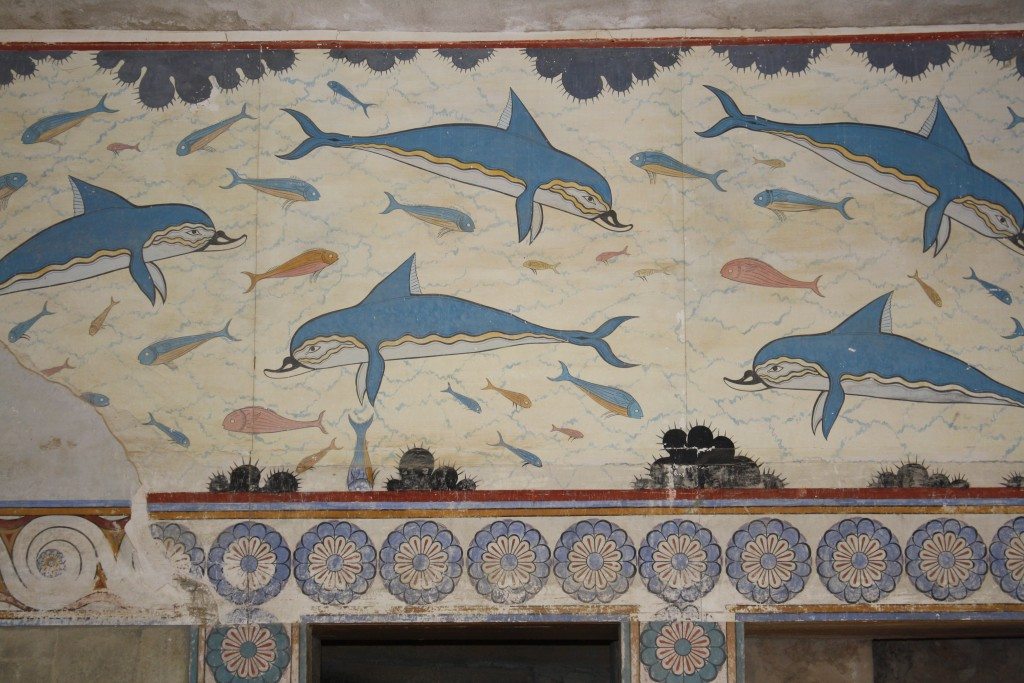
A detail of the dolphin fresco, the Minoan palace of Knossos, Crete, (c. 1700-1450 BCE). Photograph taken by Mark Cartwright for Ancient History Encyclopedia. Uploaded by Mark Cartwright, published on 26 April 2012 under the following license: Creative Commons: Attribution-NonCommercial-ShareAlike.
The Minoan civilization flourished on the Mediterranean island of Crete during the height of the Bronze Age (c. 2000-c. 1500 BCE). By virtue of their unique art and architecture, the ancient Minoans made significant contributions to the subsequent development of Western civilization. However, we still know less about the Minoans than the civilizations of Egypt or Mesopotamia. Professor Louise Hitchcock, an archaeologist specializing in Aegean archaeology at Melbourne University, introduces us to the world of the ancient Minoans and the importance of Aegean archaeology in this exclusive interview with James Blake Wiener of Ancient History Encyclopedia (AHE).
JW: Professor Louise Hitchcock, welcome to Ancient History Encyclopedia! I’m pleased to conduct this interview, as it is AHE’s first with an expert on ancient Aegean archaeology and the ancient Minoans.
I believe many AHE readers are attracted to Minoan civilization because of the inherent beauty of its art and architecture. In your research, you opine that Minoan architecture is characterized by “both tradition and innovation.” Might you comment on the ways in which this duality defines Minoan architecture and art? One would be hard pressed to deny the “monumentality”of Minoan architecture is as significant as it is grand.

This is the Minoan “Palace” at Kato Zakro in east Crete, Middle Minoan IIIB-Late Minoan IB (c. 1700-1450 BCE), which was believed to have been built to facilitate trade with the Near East. Unlike other Minoan “Palaces” its main road leads to the harbor. Photo: Courtesy of Professor Louise Hitchcock.
LH: The period of the Minoan “palaces” and of their pictorial art draws from more than 500 years of tradition. It’s not a long time in that the civilizations of ancient Egypt and China have been around longer, however, it’s quite a good record compared to many modern nation-states. As the Minoan tradition was established, they developed some true innovations in the field of architecture. Their complex use of corridors and stairways contributed to the complexity of the Minoan “palaces” and “villas,” but what really stands out is the Minoan pier-and-door partition hall.
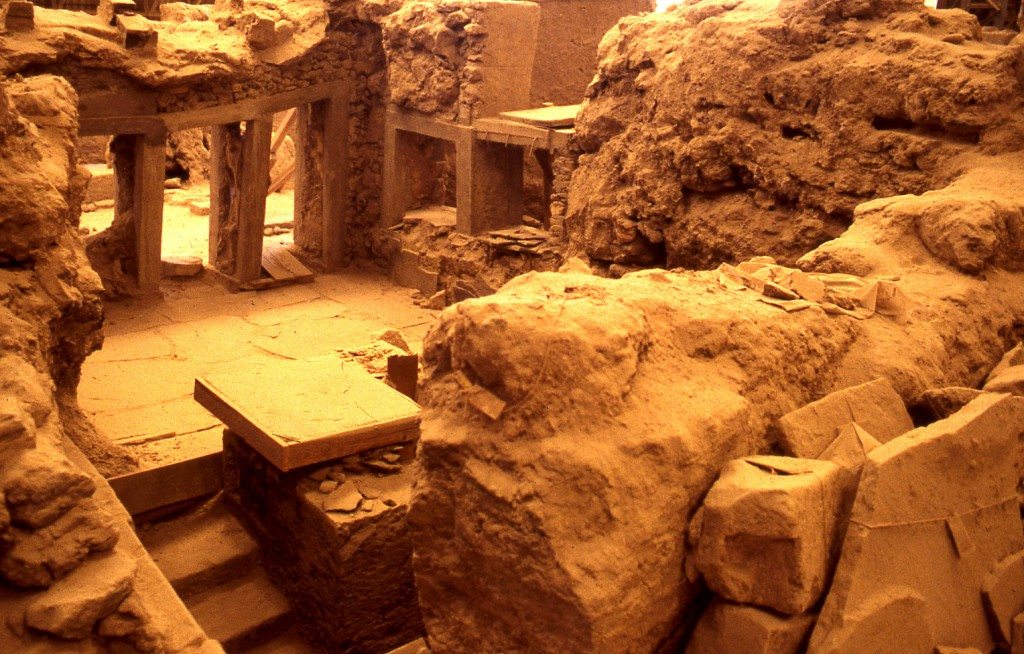
This view inside of House Xeste 3 at the site of Akrotiri on the Island of Santorini (ancient Thera) shows a small sunken room or “Lustral Basin” and pier-and-door partitions, multiple doors that can be used to open up or collapse space. The houses at Akrotiri were preserved to the second and third stories after the eruption of the ancient volcano that formed the center of the island, Late Minoan IA (c. 1614 BCE). Photo: Courtesy of Professor Louise Hitchcock.
The “Minoan hall” is one of the most notable features of Late Bronze Age architecture and enhances maze-like qualities of Minoan buildings. It is composed of several rectangular rooms separated by a row of columns and a set of square piers. The piers support double doors, which fold back into shallow recesses, allowing for the manipulation of light, ventilation, and movement. These pier-and-door partitions separate a hall into two parts, a hall and forehall. A lightwell is separated from the other two rooms by a row of columns; additionally the lightwell allows light and ventilation into the building and it could act like a miniature courtyard. The pier-and-door partitions could have been used to either collapse or open up a room. If they form two or more walls of a room, it further increases the complexity of circulation within a building. In this way, it acted in much the same way partitions serve to open up or collapse ball room spaces in modern hotels. The “Minoan hall” constitutes a feature that is uniquely “Minoan.”
JW: Professor Hitchcock, what do you believe Minoan frescoes tell us about social and cultural life on ancient Crete?
LH: I believe that their frescoes tell us about rigidly prescribed social formulas based on rituals of transition and initiation, which we see in their procession frescoes, the famous wall paintings from Akrotiri, which depict women in ritual garments picking crocuses as part of a female initiation rite, and in the famous depictions of bull leaping — which may relate to male coming of age rituals.
The naturalism and sense of liveliness found in Minoan wall painting is another aspect of the continuous innovation we see in their culture. The fresco tradition began with mud plaster, to which was added pigment, followed by experimentation with non-figural forms, and finally culminating in the animal and human compositions that are breathtaking. We catch additional glimpses of Minoan artistry in the carving of ivories and stone vases, their seal carving tradition, and in their ceramics.
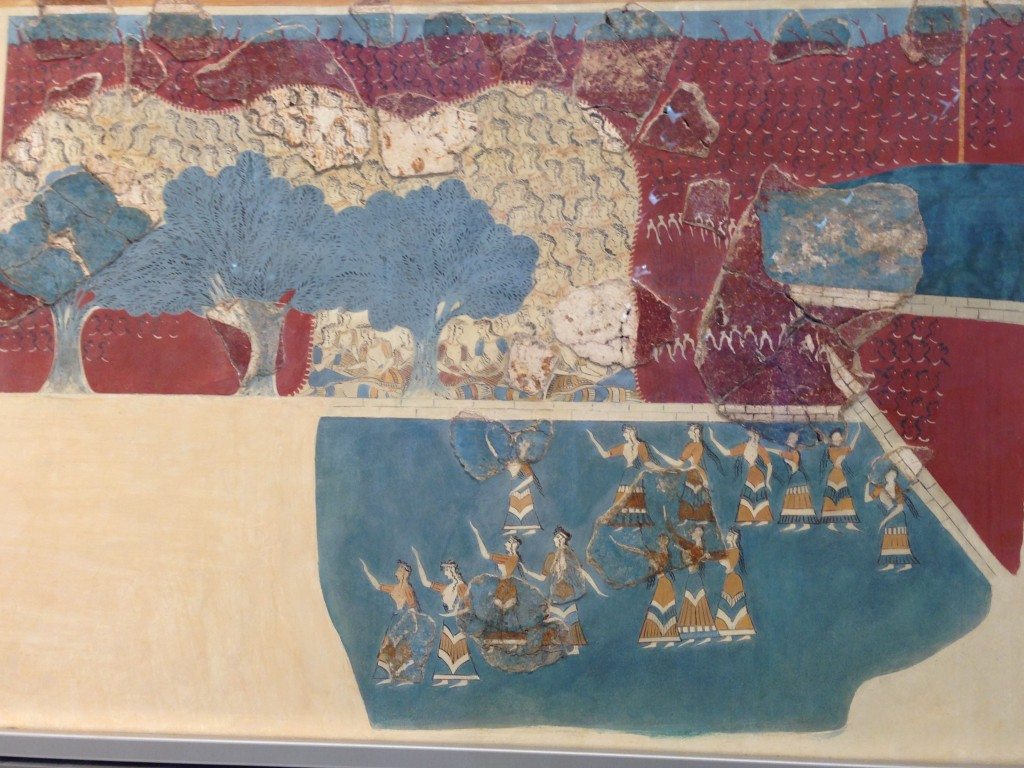
The “Sacred Grove” fresco is one the few miniature frescoes from the “Palace” at Knossos. It is also one of the earliest figural frescoes (the earlier ones being geometric motifs), dating to the beginning of the Second or New Palace Period, Middle Minoan IIIB/Late Minoan IA (c. 1700 BCE). It depicts what might be a scene of ecstatic dancing taking place on the west court of the “Palace” where there is also a triangular causeway and pits for holding trees. Notice that red is used to indicate males and white is used to indicate females — this is a convention borrowed from Egyptian art. Photo: Courtesy of Professor Louise Hitchcock.
“Even though the Minoans sailed around the Mediterranean and engaged in cultural exchange with their neighbors, while still creating something very unique, there is a tendency among many of my colleagues to not look far beyond the shores of Crete or Greece…Future Aegeanists should be looking to the fields of anthropology and looking at the contemporary neighbors of Aegean Greece, including Cyprus, Mesopotamia, Syro-Palestine, and Egypt.”
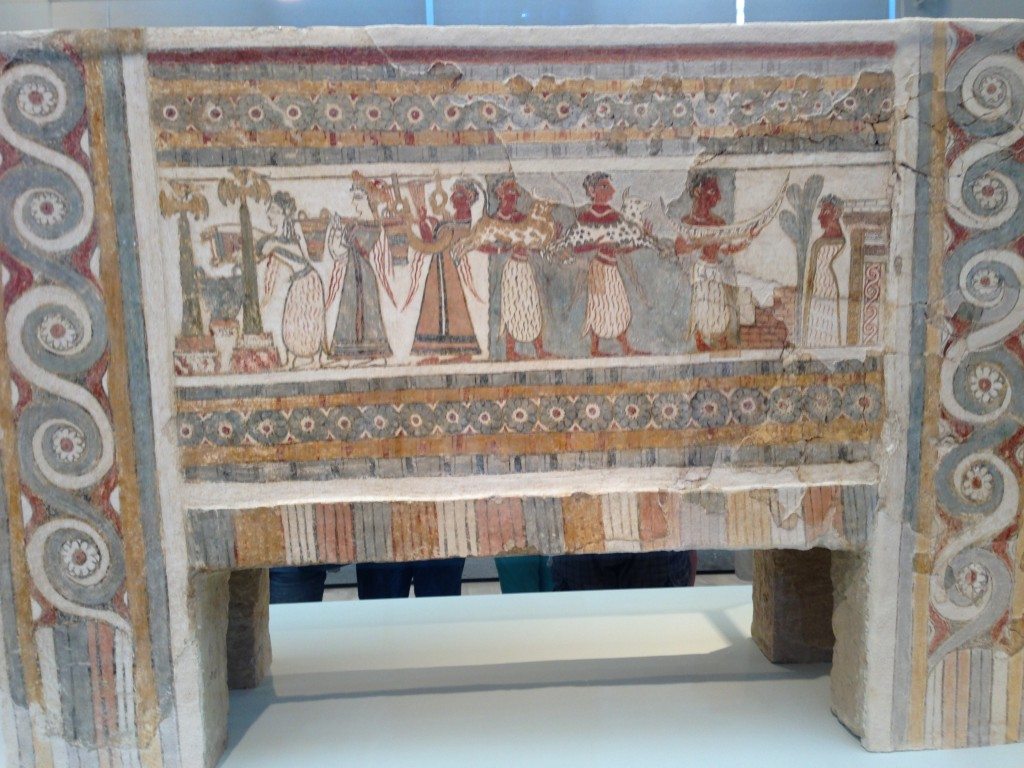
Limestone sarcophagus with painted plaster design from a tomb at Hagia Triada, Length 1.37m, Late Minoan IIIA2 (c. 1370 BCE). It shows two processional scenes: In one, priestesses pour a sacred libation into the earth between two sacred double axes on poles while a musician plays. In the second scene, offerings are brought to the deceased covered in a shroud and standing in front of his tomb. Photo: Courtesy of Professor Louise Hitchcock.
JW: You recently authored an essay on the importance of Aegean archaeology and Aegean peoples – the Minoans and Mycenaeans – in relation to our understanding of the Bronze Age in the Eastern Mediterranean. (This essay appeared in the May/June 2015 issue of Biblical Archaeology Review.)
The ancient Minoans exerted an artistic influence in the region as Minoan frescoes have been found in present-day Turkey (Militeus and
LH: I would characterize it as a relationship of back and forth influences and interactions. It’s likely that the Minoans derived their ship technology of the deep-hulled ship with mast from the peoples of the Near East, which shrank maritime space and made greater interaction possible. Crete is poor in exotic as well as in necessary raw materials such as copper, tin, gold, and ivory. In exchange for such things, they were able to trade in very fine finished products such as decorated ceramics, textiles, and even the transmission of their pictorial art through what was probably a temporary gift exchange of skilled workers. A similar phenomenon can be found if we look at the Sumerian civilization, another civilization that was poor in raw materials, but extremely creative. Being exposed to the monumental palace and temple cultures of Egypt and the Near East might have inspired the Minoans to render their own impressive versions of monumentality they saw and experienced abroad, so they could be fully fledged members of what I like to call “club east Med.” In a sense, Crete represents the westernmost sphere of Near Eastern civilization.
JW: Our collective knowledge of Minoan civilization is still rather limited, especially when compared to those of other ancient peoples in the Near East. What is the one question you wish you could answer or solve concerning the ancient Minoans?
LH: In about 1450 BCE, all of the Minoan “palaces” and “villas” are violently destroyed except for Knossos, which becomes a center of ancient Mycenaean Greek culture. In addition, there is some depopulation and Crete begins to Hellenize. I would like to know what the mechanism of this collapse was and what role the Mycenaeans played (if any). It is not a question that has been seriously addressed in Aegean scholarship.
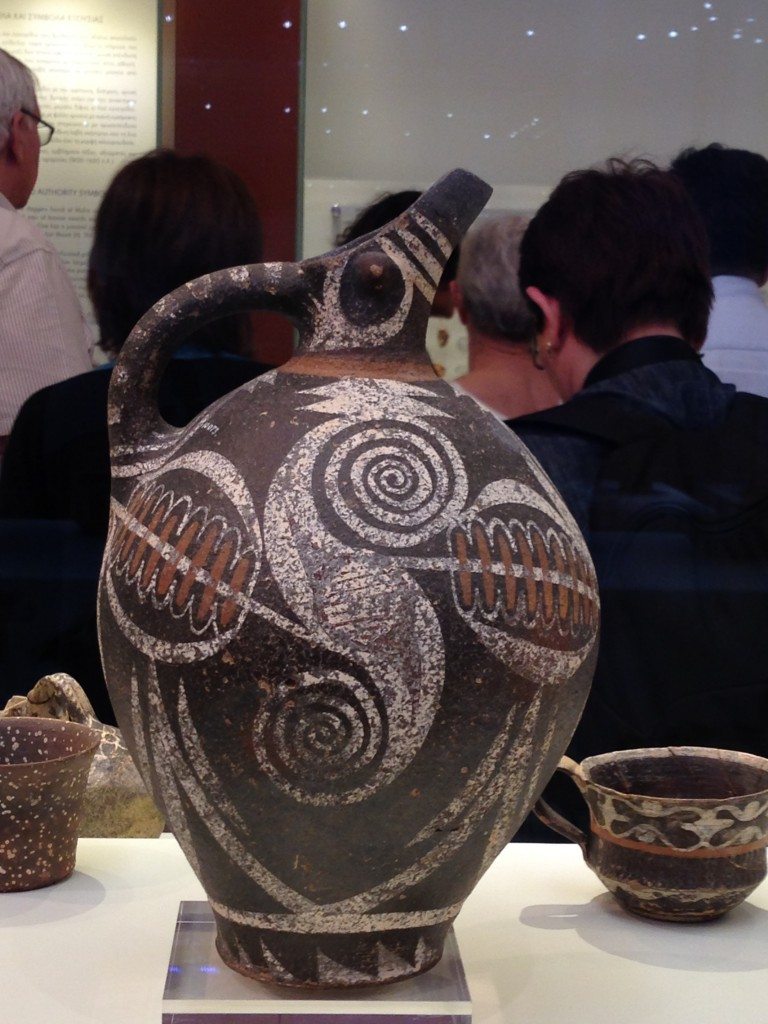
Kamares Ware, Jug with raised spout and imitation rivet, Phaistos, Storage Room XI, MM IIB (ca. 1900 BCE), Height 26.7, decorated with red or orange and white curvilinear design on a black ground. Kamares ware is a wheel-made, palatial style of feasting ware (mainly pouring and drinking vessels) named for the Kamares Cave on Mt. Ida where it was first found. Photo: Courtesy of Professor Louise Hitchcock.
JW: Do you believe that we ought to understand Minoan civilization as a “thalassocracy”?
LH: The concept of a thalassocracy is problematic as a result of the tantalizing mention in Thycidides I.4 of a thalassocracy led by the legendary King Minos. Today, it’s thought that he was emphasizing this particular aspect of Minoan culture in order to legitimize an Athenian thalassocracy. A conference on this topic held in 1982 became rather dismissive of the entire concept.
However, the conference was held at a time when we understood less than we do today about trade and interaction with the east, seafaring, the role of landscapes and seascapes, and the social structures that permitted such activities to take place. While I can’t prove that a thalassocracy existed, I believe that it is worth revisiting the topic based on more recent research and on evaluating different kinds of evidence. The ancient Minoans, followed by the Mycenaeans, existed in a time of relative stability, particularly compared to the instability found in Crete in later periods. Lack of security and stability in the maritime routes of the Mediterranean may have contributed to the emergence of the Sea Peoples’ phenomenon, which in turn, contributed to the Bronze Age Collapse. Although I cannot prove this, it is noteworthy that some of the Minoan palaces and villas were strategically positioned near harbors, rivers, gorges, and river valleys. Such positioning may have served to advertise their presence and power, and thereby promoted security on the seas.

The pillar “crypt” in the west wing of the Minoan “Palace” at Mallia, Middle Minoan II-Late Minoan IB (c. 1900-1450 BCE) was named for its small size and pillar support, which Sir Arthur Evans believed functioned as architectural representations of the stalactites and stalagmites found in sacred caves. They are always found in association with storage areas where they may have served a protective function. Photo: Courtesy of Professor Louise Hitchcock.
JW: Professor Hitchcock, what led you to pursue a career as a researcher and archaeologist with expertise in the ancient Aegean? Was there something in particular that captured your interest at a young age or a set of personal experiences, which led you to the ancient Aegean?
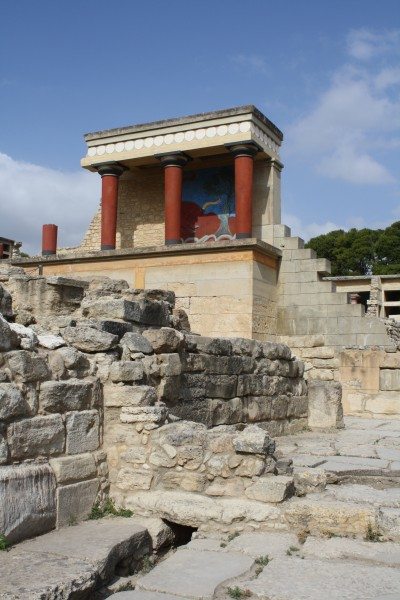
The partially reconstructed wing of the palace of Knossos c. 1500 BCE. Photograph taken by Mark Cartwright for Ancient History Encyclopedia. Uploaded by Mark Cartwright, published on 10 May 2012 under the following license: Creative Commons: Attribution-NonCommercial-ShareAlike.
LH: (laughs) I studied political science and actually came to archaeology quite late; in fact, you might call me the accidental archaeologist. I had had political ambitions and then became disillusioned with politics. I drifted around looking for something meaningful to do with my life. I came around to the conclusion that if I was going to fix the world, I needed to start with fixing myself. Around the same time, I saw Lawrence of Arabia. I went on to read 17 books about Lawrence and realized that the happiest period of his life was the time he spent as an archaeologist. At the time I was working in a stock brokerage firm and I decided to give archaeology a try through UCLA extension. I ended up doing an MA in Mesopotamian history where I served as a site photographer in Syria — coincidentally a position similar to what Lawrence had done. I enjoyed it, but was always bothered by the privileging of texts over material culture. I attended an evening lecture at UCLA by Donald Preziosi where he was an AIA guest lecturer speaking about the complexity of Minoan architecture, its spatial patterning, its complexity, and the uniqueness of Minoan civilization. You might say that I was starstruck and knew I wanted to do something along the same lines.
A couple of years later, he came to UCLA, and I changed departments (from history to art history) and areas of study (from Near Eastern studies to Aegean art) in order to work with him. During his class on Minoan art, I said that I didn’t really understand the Minoan palaces. He suggested a couple of books, which I read several times, and I realized that what they were saying sounded more like fantasy than reasoned interpretation. It was the mystery of the Minoan culture and a desire to understand Minoan civilization through their use of space that lead me to make my own attempt at interpreting the Minoan “palaces.” It is the same sense of mystery that has led me to study the Philistines and the Sea Peoples. I think of it as being like peeling an onion…
I guess that the moral of my own story is that great art, big ideas, and great teachers can change your life. The role of the arts and humanities as well as that of great teachers to inspire creative thinking is becoming devalued by (too numerous and overpaid) university administrators and politicians emphasizing a bottom-line utility. They fail to realize that the arts along with obtaining cultural and historical knowledge promote the critical thinking skills that have served modern society.
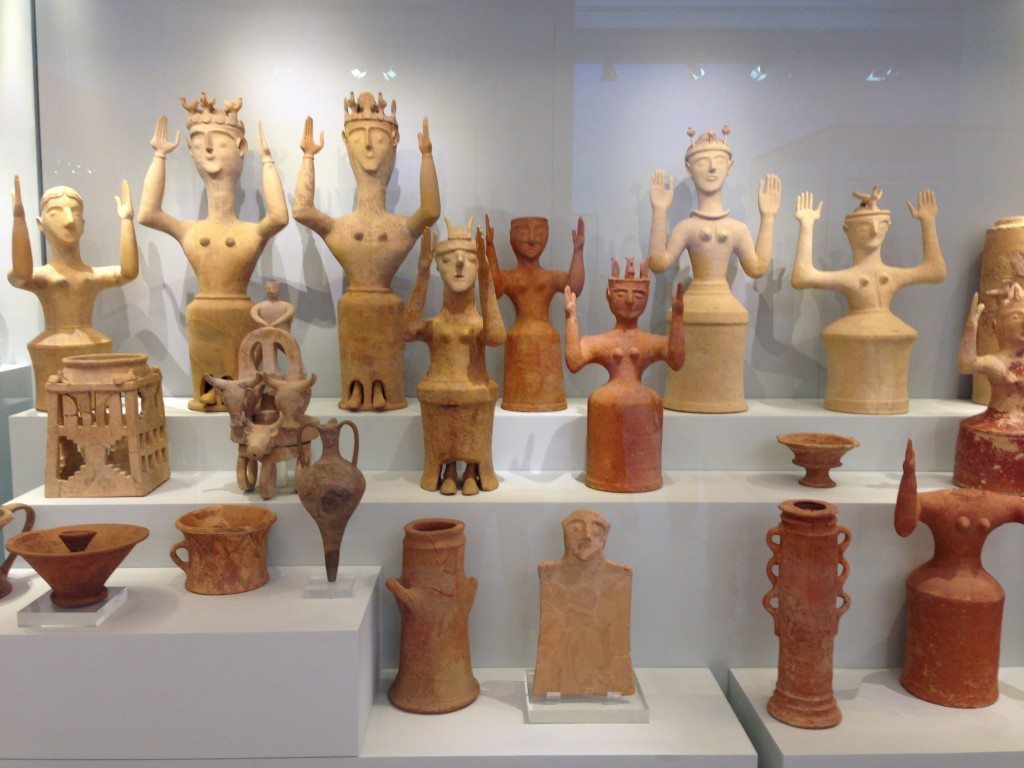
These Minoan “Goddesses” with Upraised Arms (MGUA) are clay, wheel made statuettes that were found in small, bench shrines of refuge settlements of the Late Minoan IIIC period (c. 12th century BCE), founded following the collapse of the Mycenaean palaces. Photo: Courtesy of Professor Louise Hitchcock.
JW: Aegean archaeology is an exciting and emerging subfield of archaeology. What specific challenges lay ahead for future archaeologists who study the ancient Aegean, and what is the single piece of advice that you’d offer them?
LH: I see a couple major challenges. One is the exposure of the Minoan “palaces” and “villas” to the elements. Every time I return to Crete, they are in worse shape than the last time I visited. Many are under- or poorly published. We house literally hundreds of similar to identical artifacts in museums and storerooms where they are protected, yet these one of a kind architectural masterpieces are crumbling before our eyes. Future students who believe that perhaps my generation or the previous generations of scholars got it wrong, will not have the privilege of being able to return to the same architectural archive of primary evidence. Another challenge is the increasing narrow disciplinary focus of Aegean art and archaeology.
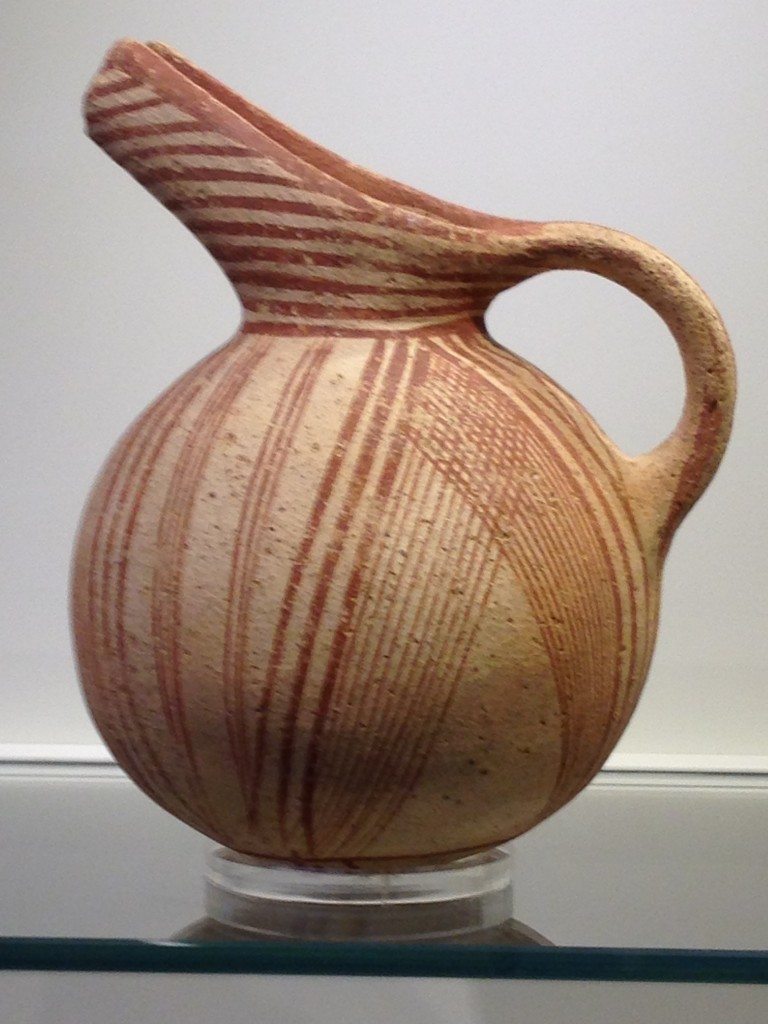
Aghios Onouphrios Ware Jug, Aghios Onouphrios (near Phaistos in south central Crete), Height 21.5 cm, decorated with red paint on buff clay, with two groups of converging diagonal lines with their ends crossed and repeated several times, Early Minoan I (c. 2800-2500 BCE). Photo: Courtesy of Professor Louise Hitchcock.
Even though the ancient Minoans sailed around the Mediterranean and engaged in cultural exchange with their neighbors, while still creating something very unique, there is a tendency among many of my colleagues to not look far beyond the shores of Crete or Greece. In addition, many receive their training in the study of classics, that is, in the study of the later cultures Greece and Rome. Future Aegeanists should be looking to the fields of anthropology and looking at the contemporary neighbors of Aegean Greece, including Cyprus, Mesopotamia, Syro-Palestine, and Egypt.
JW: Professor Hitchcock, I thank you so much for your time and consideration. It’s been a pleasure to speak with you. I hope we can do it again in the near future – perhaps once another palace or fresco has been discovered!
LH: I’m ready James! Thank you.
A UCLA graduate, Professor Louise Hitchcock has extensive archaeological experience in the east Mediterranean, including time as Parsons Fellow at the American School of Classical Studies in Athens, a senior Fulbright Fellow at the Cyprus American Archaeological Research Institute in Cyprus; as an USAID Fellow, a National Endowment for the Humanities Fellow, and the Visiting Annual Professor at the Albright Institute of Archaeological Research in Jerusalem; and a visiting researcher at the Institute of Advanced Study at Hebrew University, Jerusalem. Hitchcock has undertaken excavation work in Israel, Egypt, Syria, Crete, and California. She is author of more than 40 articles on architecture and gender in the east Mediterranean. Her three books include: Minoan Architecture: A Contextual Analysis, Aegean Art and Architecture (co-authored with Donald Preziosi), Theory for Classics, and The Aegean Feast (co-edited with Robert Laffineur and Janice Crowley). Hitchcock currently teaches at Melbourne University in Melbourne, Australia in the School of Historical and Philosophical Studies.
All images featured in this interview have been attributed to their respective owners. Images lent to the Ancient History Encyclopedia by Professor Louise Hitchcock have been done so as a courtesy for the purposes of this interview. Unauthorized reproduction is strictly prohibited. All rights reserved. © AHE 2015. Please contact us for rights to republication.

